Electrocardiogram
ECG; EKG
An electrocardiogram (ECG) is a test that records the electrical activity of the heart.
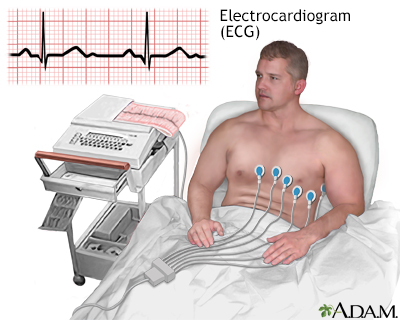
The electrocardiogram (ECG) is used extensively in the diagnosis of heart disease, from congenital heart disease in infants to myocardial infarction and myocarditis in adults. Several different types of electrocardiogram exist.
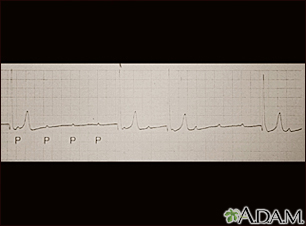
This picture shows an ECG (electrocardiogram, EKG) of a person with an abnormal rhythm (arrhythmia) called an atrioventricular (AV) block. P waves show that the top of the heart received electrical activity. Each P wave is usually followed by the tall (QRS) waves. QRS waves reflect the electrical activity that causes the heart to contract. When a P wave is present and not followed by a QRS wave (and heart contraction), there is an atrioventricular block, and a very slow pulse (bradycardia).
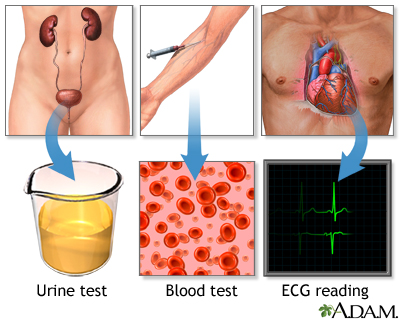
Routine lab tests are recommended before beginning treatment of high blood pressure to determine organ or tissue damage or other risk factors. These lab tests include urinalysis, blood cell count, blood chemistry (potassium, sodium, creatinine, fasting glucose, total cholesterol and HDL cholesterol), and an ECG (electrocardiogram). Additional tests may be recommended based on your condition.
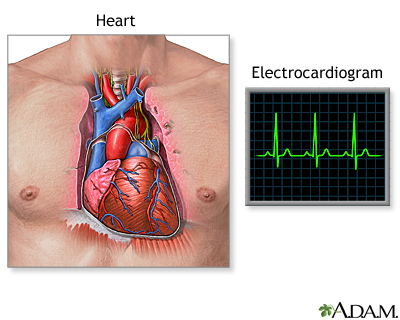
An electrocardiogram is a test that measures the electrical activity of the heart. This includes the rate and regularity of beats as well as the size and position of the chambers, any damage to the heart, and effects of drugs or devices to regulate the heart.
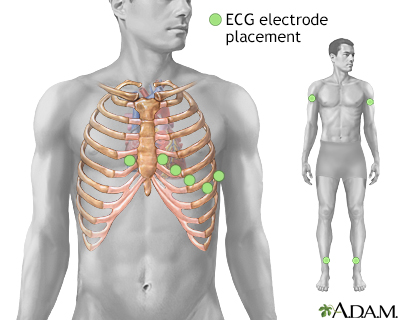
An ECG is very useful in determining whether a person has heart disease. During an ECG electrodes are affixed to each arm and leg and to the chest.

Action potentials generated by heart cells produce weak electrical currents that spread throughout the body. These currents can be detected at the surface of the body and amplified using an instrument known as an electrocardiograph. The graphic recording produced by an electrocardiograph of the heart electric activity is called an electrocardiogram, or ECG.

A typical ECG tracing has 4 recognizable waves, called deflection waves. These waves are labeled alphabetically as the P wave, the QRS complex, the T wave, and the U wave. The first wave is called the P wave. It results from atrial muscle cell depolarization. Beginning with the depolarization of autorhythmic cells of the SA node, and resulting in the spread of depolarization wave through the atria. The P wave lasts less than 120 milliseconds (0.12 seconds). Shortly after the P wave begins, the atria contract, resulting in atrial systole. The QRS complex is the result of the depolarization of the conduction system in the ventricles, and its spread through the walls of the ventricles. It represents electric activity that precedes the contraction of the ventricles (ventricular systole). Ventricular systole begins shortly after the QRS complex appears. The QRS has a complex shape that may consist of up to 3 waves. This is due to the passage of depolarization wave down the interventricular septum, and through the septum from left to right, upward from the apex, and through the lateral walls of the ventricles. In a typical ECG, the Q wave is the initial downward deflection. The R wave is an upward deflection, while the S wave is the second downward deflection. The shape of QRS complex varies from one ECG lead to another. For example, it may consist of only an R wave, QS waves with no R wave, or RS waves with no Q wave. The normal duration of a QRS complex is between 70 milliseconds (0.07 seconds) and 100 milliseconds (0.1 seconds). During the formation of the QRS complex, atrial repolarization (electrical recovery) takes place, which is not usually evident on an ECG due to the large QRS complex that masks it. The T wave reflects ventricular repolarization. Because ventricle repolarization is slower than depolarization, the T wave is more spread out than the QRS complex. A normal T wave is usually smooth and rounded, and has the same deflection orientation (same direction), as the QRS complex. A typical T wave lasts approximately 160 milliseconds (0.16 seconds). Shortly after the T wave begins, the ventricles start to relax. The U wave is a low-amplitude, rounded deflection that follows the T wave in certain ECGs. It normally has the same deflection orientation as the T wave. The physiological basis of the U wave is not clear. However, an abnormal increase in its amplitude is an indication of hypokalemia, or could be caused by certain drugs, such as quinidine and procainamide.
How the Test is Performed
You will be asked to lie down. A technician will clean several areas on your arms, legs, and chest, and then will attach small patches called electrodes to those areas. It may be necessary to shave or clip some hair so the patches stick to the skin. The number of patches used may vary.
The patches are connected by wires to a machine that turns the heart's electrical signals into wavy lines, which are often printed on paper. The health care provider reviews the test results.
You will need to remain still during the procedure. The technician may also ask you to hold your breath for a few seconds as the test is being done.
It is important to be relaxed and warm during an ECG recording because any movement, including shivering, can alter the results.
Sometimes this test is done while you are exercising or under light stress to look for changes in the heart. This type of ECG is often called a stress test.
How to Prepare for the Test
Make sure your provider knows about all the medicines you are taking. Some medicines can interfere with test results.
Do not exercise or drink cold water immediately before an ECG because these actions may cause false results.
How the Test will Feel
An ECG is painless. No electricity is sent through the body. The electrodes may feel cold when first applied. In rare cases, some people may develop a rash or irritation where the patches were placed.
Why the Test is Performed
An ECG is used to measure:
- Any damage to your heart
- How fast your heart is beating and whether it is beating normally
- The effects of medicines or devices used to control your heart (such as a pacemaker)
- The size and position of your heart chambers
An ECG is often the first test done to determine whether a person has heart disease. Your provider may order this test if:
- You have chest pain or palpitations
- You are scheduled for surgery
- You have had heart problems in the past
- You have a strong history of heart disease in the family
Normal Results
Normal test results most often include:
- Heart rate: 60 to 100 beats per minute
- Heart rhythm: Consistent and even
What Abnormal Results Mean
Abnormal ECG results may be a sign of:
- Damage or changes to the heart muscle
- Changes in the amount of the electrolytes (such as potassium and calcium) in the blood
- Congenital heart defect
- Enlargement of the heart
- Fluid or swelling in the sac around the heart
- Inflammation of the heart (myocarditis)
- Past or current heart attack
- Poor blood supply to the heart arteries
- Abnormal heart rhythms (arrhythmias)
Some heart problems that can lead to changes on an ECG test include:
Risks
There are no risks.
Considerations
The accuracy of the ECG depends on the condition being tested. A heart problem may not always show up on the ECG. Some heart conditions never produce any specific ECG changes.
References
Brady WJ, Harrigan RA, Chan TC. Basic electrocardiographic techniques. In: Roberts JR, Custalow CB, Thomsen TW, eds. Roberts and Hedges' Clinical Procedures in Emergency Medicine and Acute Care. 7th ed. Philadelphia, PA: Elsevier; 2019:chap 14.
Ganz L, Link MS. Electrocardiography. In: Goldman L, Cooney KA, eds. Goldman-Cecil Medicine. 27th ed. Philadelphia, PA: Elsevier; 2024:chap 42.
Mirvis DM, Goldberger AL. Electrocardiography. In: Libby P, Bonow RO, Mann DL, Tomaselli GF, Bhatt DL, Solomon SD, eds. Braunwald's Heart Disease: A Textbook of Cardiovascular Medicine. 12th ed. Philadelphia, PA: Elsevier; 2022:chap 14.
Version Info
Last reviewed on: 5/8/2024
Reviewed by: Thomas S. Metkus, MD, Assistant Professor of Medicine and Surgery, Johns Hopkins University School of Medicine, Baltimore, MD. Also reviewed by David C. Dugdale, MD, Medical Director, Brenda Conaway, Editorial Director, and the A.D.A.M. Editorial team.
